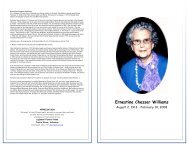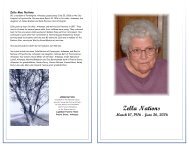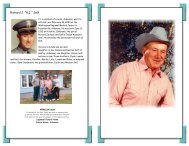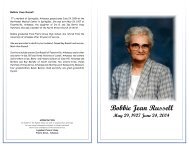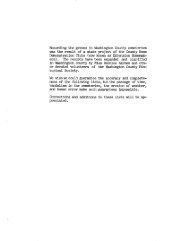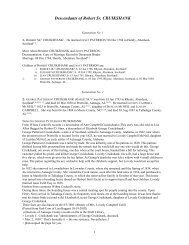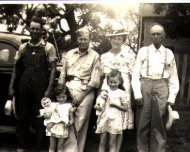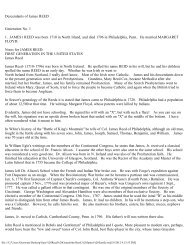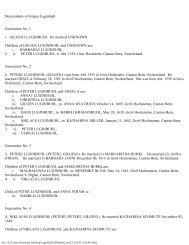Snodgrass Family History Book
The Snodgrass Family History Book - Luginbuel Funeral Home
The Snodgrass Family History Book - Luginbuel Funeral Home
Create successful ePaper yourself
Turn your PDF publications into a flip-book with our unique Google optimized e-Paper software.
<strong>Snodgrass</strong> <strong>Family</strong> Documents, Stories & Articles<br />
died in Sullivan County, Tennessee. William <strong>Snodgrass</strong><br />
married Priscilla had son David <strong>Snodgrass</strong> who married<br />
Elizabeth Johnson had daughter Priscilla <strong>Snodgrass</strong> who<br />
married George Pile. Source 5 - <strong>Book</strong> 57 page 86<br />
Col. William <strong>Snodgrass</strong> of Washington County. Virginia,<br />
Sullivan County, Tennessee son of David and Martha<br />
(Glenn) <strong>Snodgrass</strong> son of William and Catherine (Patterson)<br />
<strong>Snodgrass</strong>. Source 5<br />
At the time of the outbreak of the Revolutionary War he was<br />
living in Washington ('ounty, Virginia and he continued to<br />
live in that county throughout the war. He was to sec active<br />
1nilitary service on at least seven different occasions during<br />
the war and appears to have been a volunteer every time.<br />
Most of his service was as a Private, but he served as a<br />
Sergeant on at least one occasion. (N .B. - Several sources<br />
state that he was an officer during this war but such was not<br />
the case.) Following is a chronological account of his<br />
service taken pritnarily from his pension application 1nore<br />
than 50 years later; his age then and resultant faulty memory<br />
caused his account to be somewhat disjointed and lacking in<br />
detail.<br />
During the summer of 1775 he volunteered for service under<br />
Captain George Adams and was kept in Washington County,<br />
Virginia to guard the frontier inhabitants against the Indians.<br />
his company pursued a party of Indians below the Big Lick<br />
on Sandy River and overtook them. In the ensuing fight<br />
they routed the Indians and then pursued them onward to the<br />
Cumberland Mountains before stopping. This tour \Vas<br />
about six to eight weeks in length.<br />
Within two or three days after returning home he again<br />
volunteered for service under Captain Edmonton and the<br />
company returned to the sa1ne section of the country where<br />
they had previously been. This time the company was<br />
divided and he vvas stationed at NC\\' Garden Fort for about<br />
six to eight weeks before being discharged from duty again.<br />
In the summer of 1778 he volunteered again and served one<br />
tour of two months in length under Lieut. William<br />
McCoones (or McCooney) and another tour of duty of two<br />
months as a substitute for James Glenn. In one of these<br />
tours (probably the latter) he was again stationed at New<br />
Garden Fort under Sergeant William McCormick of Captain<br />
James Dorsey's Company (name also seen as Daisey).<br />
In the winter of 1779 he volunteered under Captain Lev~ris<br />
and Captain Evan Shelby and Participated as a Sergeant in<br />
the Chickamauga Campaign. They marched against the<br />
Chickamauga tribe of the Cherokee Nation and burned 12<br />
Indian towns, killed some Indians, took some prisoners and<br />
destroyed and burned the Indians com before returning<br />
home. This tour was of about four months duration.<br />
In the summer of 1776 he volunteered again for service<br />
under Captain George Adams and served another six months<br />
in Washington County guarding the inhabitants against the<br />
Indians.<br />
At an unknown time during 1776 he also volunteered to<br />
guard some wagons that were going to the head of New<br />
River to the lead mines (about 80 or 90 mi. from<br />
Washington County) for the purpose of procuring lead to<br />
supply the different forts in Washington County, Virginia.<br />
Ile stated that he did not serve under any particular officer<br />
during this period of duty.<br />
About that same time or shortly after his return he was<br />
ordered by Col. (then Capt.) William Edmonton to take<br />
charge of a company of men to apprehend a man by the<br />
name of Cummings who had been charged with having set<br />
the Cherokee Indians onto the frontier settlers. He pursued<br />
the man above the salt works in Washington County where<br />
he took him prisoner and brought him back and delivered<br />
him to Col. Dorsey.<br />
In the summer of 1777 he volunteered under Capt. William<br />
Edmonton and was marched to Ne\v Garden Fort on the<br />
waters of Clinch River (now in Russell County, Virginia).<br />
He was also at Richland Fort (now in Tazewell County),<br />
Capt. Smith's Fort, and Elk Garden Fort (now in Russell<br />
County. During this tour of duty the Shawnee Indians were<br />
frequently killing the frontier settlers and on one occasion<br />
In the fall of 1780 he volunteered under Captain Andrew<br />
Colville, Colonel William Campbell's Virginia Regiment,<br />
and they marched to Cleveland County. North Carolina. He<br />
is said to have served as a leader of the scouts under Col.<br />
Cainpbell. He participated in the Battle of King's Mountain<br />
on 7 Oct 1780 where a force of about 900 Americans<br />
opposed l IOO British and in an hour's fighting the British<br />
lost about 250 killed and wounded (including Col. Ferguson<br />
killed) and 664 men taken prisoner while the Americans lost<br />
only 28 men killed - although a large number were wounded.<br />
William added that a few days af\er the battle he received a<br />
permit to go do\\ 1 n Catawba River on business where he<br />
remained ten or twelve days on account of high water.<br />
Since Colonel Tarlton's troops were in this section of the<br />
country at that time, he and another man in the same<br />
company with him took to the woods and made their way to<br />
General Su1nter and General Davis' anny. They received a<br />
message to Col. Campbell whose army they again joined at<br />
the Moravian town where the army and prisoners were. He<br />
was discharged in the Moravian town (he said they remained<br />
there four days until a sufficient number of Whigs could be<br />
collected to pass the Blue Ridge, as there were bodies of<br />
Tories in that range of mountains) and returned home after<br />
four months service.<br />
In the summer of 1781 he served another tour of indefinite<br />
lenb'1h in which he was engaged in dispersing Tories in<br />
different parts of the county. In the fall of 1781 he<br />
7/9/01 The Norwood <strong>Family</strong> <strong>History</strong> Page 10-163



